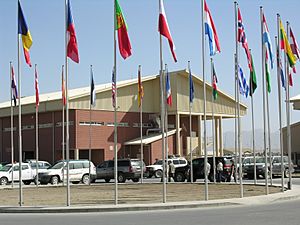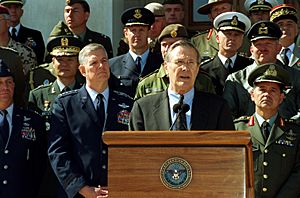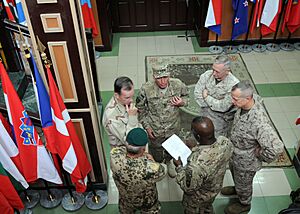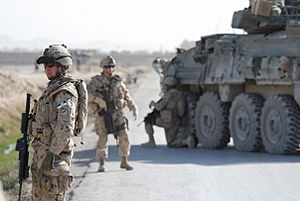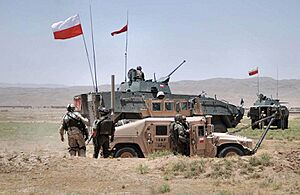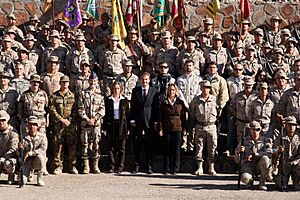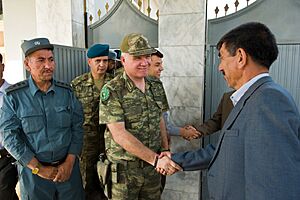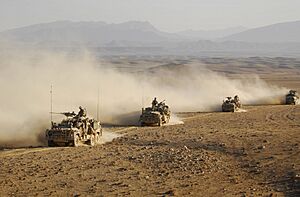International Security Assistance Force facts for kids
Quick facts for kids International Security Assistance Force |
|
|---|---|
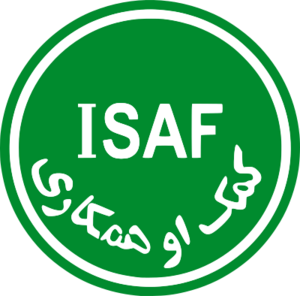
Official logo of the ISAF
|
|
| Country | See list |
| Allegiance | |
| Size | 130,000 (About to be deployed in 2012) |
| Part of | Allied Joint Force Command Brunssum American contingent responsible to: United States Central Command MacDill Air Force Base, Florida, U.S. |
| Headquarters | Kabul, Afghanistan |
| Motto(s) | "Assistance and Cooperation" Persian: کمک و همکاری Kumak u Hamkāri Pashto: کمک او همکاري Kumak aw Hamkāri |
| Commanders | |
| Notable commanders |
Gen. John F. Campbell (2014) |
| Insignia | |
| Flags |   |
The International Security Assistance Force (ISAF) was a large group of military forces from many countries. They worked together in Afghanistan from 2001 to 2014. The United Nations Security Council created ISAF to help Afghanistan after the U.S. invasion in 2001.
ISAF's main goals were to train the Afghan National Security Forces (ANSF) and help Afghanistan rebuild its government. Over time, ISAF also became involved in fighting against the Taliban insurgency.
At first, ISAF's job was to keep the capital city, Kabul, safe. In 2003, NATO took charge of the mission. This was the first time NATO had sent troops outside Europe and North America. Soon after, ISAF's mission grew to cover more areas beyond Kabul. By 2006, ISAF was responsible for security across the entire country.
At its busiest, between 2010 and 2012, ISAF had about 130,000 troops and 400 military bases in Afghanistan. A total of 42 countries, including all 30 NATO members, sent troops. The United States sent the most troops. Other big contributors included the United Kingdom, Turkey, Germany, France, and Italy.
ISAF stopped its combat operations in December 2014. Its job was to help Afghan forces take over security. Some troops stayed behind to advise and support as part of a new group called the Resolute Support Mission.
Contents
ISAF's Area of Work
For nearly two years, ISAF only worked in Kabul. Expanding beyond Kabul would have needed many more soldiers. The plan was for the new Afghan National Army to handle security across Afghanistan.
However, on October 13, 2003, the UN Security Council voted to let ISAF work outside Kabul. Soon after, Canadian soldiers, who made up almost half of the force then, said they would not go outside Kabul.
On October 24, 2003, Germany decided to send troops to the Kunduz region. About 230 more soldiers went there. This was the first time ISAF troops worked outside Kabul. By July 31, 2006, NATO-led ISAF took control of the southern part of Afghanistan. By October 5, it also took control of the eastern part.
ISAF's Journey Through Time
ISAF's first main office was led by Major General John McColl from the UK. This group arrived in December 2001. At first, ISAF had a main office and one brigade (a large military unit) that covered Kabul.
In February 2002, 18 countries were helping ISAF. The force was expected to grow to 5,000 soldiers. Turkey took command of ISAF in June 2002. By November 2002, ISAF had 4,650 troops from over 20 countries.
On February 10, 2003, German Lieutenant General Norbert van Heyst took command. By March 2003, ISAF had 4,700 troops from 28 countries. On June 7, 2003, a bomb attack in Kabul killed four German soldiers and wounded many others.
At first, different countries took turns leading ISAF every six months. But it was hard to find new countries to lead. So, on August 11, 2003, NATO took over command of ISAF for good. This was NATO's first mission outside Europe or North America.
- In February 2002, South Korea sent 99 medical soldiers.
- From February to July 2002, Portugal sent a medical team and an air team.
Expanding Across Afghanistan
ISAF expanded its operations in stages:
Stage 1: Moving North (Completed October 2004)
- On August 11, 2003, NATO took command of ISAF, which had 5,000 troops from over 30 countries. Most of these troops were from NATO nations. Canada sent the largest group, with 1,950 soldiers.
- On October 13, 2003, the UN allowed ISAF to do more than just support the government in Kabul.
- In December 2003, NATO decided to expand ISAF by taking over a German-led Provincial Reconstruction Team (PRT) in Kunduz. PRTs are small teams that help with security and rebuilding in different areas.
- By October 2004, ISAF's area covered about 3,600 square kilometers in the north. This allowed the mission to help with security in nine northern provinces.
Stage 2: Moving West (Completed September 2005)
- On February 10, 2005, NATO announced that ISAF would expand into western Afghanistan. This started on May 31, 2006.
- ISAF took command of two more PRTs in Herat and Farah. By September, two more ISAF-led PRTs in Chaghcharan and Qala-e-Naw were working.
- This expansion meant ISAF was now helping with security in 50 percent of Afghanistan.
- On August 5, 2005, Italian General Mauro del Vecchio took command of ISAF.
- In September 2005, Stage 2 was finished. NATO also sent 2,000 more troops to help with the parliamentary elections.
Stage 3: Moving South (Completed July 2006)
- On December 8, 2005, NATO leaders approved a plan to expand ISAF to the south in 2006. This was called Stage 3.
- ISAF took command of six more provinces in the south: Day Kundi, Helmand, Kandahar, Nimroz, Uruzgan, and Zabul.
- The number of ISAF forces grew from about 10,000 to 20,000.
- On July 31, 2006, Stage 3 was completed. A new command center was set up in Kandahar, led by Canada with 8,000 soldiers.
- The Taliban started to gather again, especially in Kandahar. NATO launched a big attack called Operation Medusa in September 2006.
Stage 4: Covering the Whole Country (Completed October 2006)
- On October 5, 2006, ISAF took over command of international military forces in eastern Afghanistan. This was the final stage of its expansion.
- With this, ISAF was helping the Afghan government provide security across the entire country.
- 10,000 more troops came under NATO command. There were now 31,000 ISAF troops in Afghanistan.
ISAF After 2006
- In November 2006, a study showed that over 3,700 people died in Afghanistan that year. About 1,000 of them were civilians.
- In November 2006, NATO leaders met in Latvia. They discussed how some countries did not want to send troops to fight in southern Afghanistan. Some countries agreed to ease their rules for sending troops.
- On December 15, 2006, ISAF started a new attack against the Taliban called Operation Baaz Tsuka in Kandahar province.
- On February 4, 2007, U.S. General Dan K. McNeill became the new ISAF commander. He planned to focus more on fighting.
- On March 6, 2007, NATO-ISAF launched Operation Achilles to improve security in northern Helmand. This operation involved over 4,500 NATO troops and nearly 1,000 Afghan soldiers.
- On June 2, 2008, General David D. McKiernan took command of ISAF. By 2009, ISAF had about 55,100 troops.
- On June 15, 2009, General Stanley A. McChrystal became the new NATO commander.
- On July 2, 2009, ISAF launched Operation Strike of the Sword in Helmand Province. This was the largest U.S. Marine attack since 2004.
- Starting in 2010, the Afghanistan Mission Network became the main way for troops to share information.
- On July 4, 2010, General David Petraeus took command of NATO forces.
Some NATO countries announced plans to withdraw troops starting in 2010. Canada left in 2011, Poland in 2012, and the United Kingdom in 2010. The United States ended its combat operations in Afghanistan in December 2014. Many advisory forces stayed to train Afghan security forces. NATO continued with the Resolute Support Mission.
Helping with Security and Rebuilding
From 2006, the Taliban's attacks became stronger, especially in the southern parts of the country. After ISAF took over the south on July 31, 2006, British, Dutch, Canadian, and Danish ISAF soldiers faced almost daily attacks. British commanders said the fighting was the toughest they had seen in 50 years.
Because of the difficult security situation, ISAF commanders asked member countries for more troops. On October 19, the Dutch government decided to send more troops. This was because of increasing attacks by the Taliban, which made it hard to do reconstruction work.
Military and Civilian Safety
The number of ISAF military deaths and civilian deaths caused by the war became a big issue. More civilian deaths threatened the stability of President Hamid Karzai's government.
To help with this, on July 2, 2009, General Stanley A. McChrystal ordered Coalition forces to try their best to avoid harming Afghan civilians during operations.
Another problem was "insider attacks," where Afghan soldiers would sometimes shoot ISAF soldiers. These attacks became less frequent as combat operations were planned to end. However, on August 5, 2014, an Afghan soldier shot and killed a U.S. general, Harold J. Greene, and wounded about 15 other officers and soldiers near Kabul.
How ISAF Was Organized in 2011


ISAF had different Regional Commands (RCs) across Afghanistan. Each RC had smaller teams called Provincial Reconstruction Teams (PRTs) that helped with security and rebuilding. By November 2006, there were 25 PRTs. The main ISAF headquarters was in Kabul.
In October 2010, there were 6 Regional Commands:
- Regional Command Capital (Kabul): This area was led by Turkey, France, or Italy. Most French forces were here.
- Regional Command North: This area was led by Germany and included troops from the U.S., Croatia, Norway, Belgium, Sweden, and Hungary.
- Regional Command West: This area was led by Italy and included troops from Spain, the U.S., and Lithuania.
- Regional Command South: This area was led by the U.S. and included troops from Canada and Australia. It covered provinces like Kandahar and Uruzgan.
- Regional Command East: This area was led by the U.S. and included troops from France, Turkey, New Zealand, Poland, and the Czech Republic. It covered provinces like Bagram and Ghazni.
- Regional Command Southwest: This area was created in July 2010. It was responsible for security in Helmand and Nimroz provinces. It included troops from the U.S., UK, Georgia, Denmark, Bahrain, and Estonia.
Leaders of ISAF
The person in charge of ISAF changed over time. Since February 2007, only American generals have led ISAF.
| No. | Portrait | Name (born-died) |
Term of office | Defence branch | Notes | ||
|---|---|---|---|---|---|---|---|
| Took office | Left office | Time in office | |||||
| 1 | Major general John C. McColl (born 1952) |
10 January 2002 | 20 June 2002 | 161 days | First ISAF leader. | ||
| 2 | Lieutenant general Hilmi Akin Zorlu |
20 June 2002 | 10 February 2003 | 235 days | |||
| 3 | Lieutenant general Norbert van Heyst (born 1944) |
10 February 2003 | 11 August 2003 | 182 days | |||
| 4 | Lieutenant general Götz Gliemeroth (born 1943) |
11 August 2003 | 9 February 2004 | 182 days | |||
| 5 |  |
Lieutenant general Rick J. Hillier (born 1955) |
9 February 2004 | 9 August 2004 | 182 days | ||
| 6 | Lieutenant general Jean-Louis Py |
9 August 2004 | 13 February 2005 | 188 days | |||
| 7 | Lieutenant general Ethem Erdağı |
13 February 2005 | 5 August 2005 | 173 days | |||
| 8 |  |
Corps General Mauro del Vecchio (born 1946) |
5 August 2005 | 4 May 2006 | 272 days | ||
| 9 |  |
General Sir David J. Richards (born 1952) |
4 May 2006 | 4 February 2007 | 276 days | ||
| 10 |  |
General Dan K. McNeill (born 1946) |
4 February 2007 | 3 June 2008 | 1 year, 120 days | First American commander. | |
| 11 |  |
General David D. McKiernan (born 1950) |
3 June 2008 | 15 June 2009 | 1 year, 12 days | ||
| 12 |  |
General Stanley A. McChrystal (born 1954) |
15 June 2009 | 23 June 2010 | 1 year, 8 days | ||
| – |  |
Lieutenant general Nick Parker (born 1954) |
23 June 2010 | 4 July 2010 | 11 days | Interim commander. | |
| 13 |  |
General David H. Petraeus (born 1952) |
4 July 2010 | 18 July 2011 | 1 year, 14 days | ||
| 14 |  |
General John R. Allen (born 1953) |
18 July 2011 | 10 February 2013 | 1 year, 207 days | ||
| 15 | General Joseph F. Dunford Jr. (born 1955) |
10 February 2013 | 26 August 2014 | 1 year, 197 days | |||
| 16 |  |
General John F. Campbell (born 1957) |
26 August 2014 | 28 December 2014 | 124 days | Last ISAF commander. | |
Countries That Helped ISAF

Many countries sent troops to ISAF. All NATO member states helped, along with some other partner countries.
NATO Countries

 Albania – Sent special forces and other troops, mainly working with Italian and Turkish commands.
Albania – Sent special forces and other troops, mainly working with Italian and Turkish commands. Belgium – Provided security at Kabul International Airport and sent F-16 fighter jets.
Belgium – Provided security at Kabul International Airport and sent F-16 fighter jets. Bulgaria – Sent troops to train Afghan forces and provide security, mainly in Kandahar.
Bulgaria – Sent troops to train Afghan forces and provide security, mainly in Kandahar. Canada – Actively fought the Taliban in the south and had a large air force presence. Canada completed its mission in March 2014.
Canada – Actively fought the Taliban in the south and had a large air force presence. Canada completed its mission in March 2014. Croatia – Sent about 450 soldiers to three locations, helping to train local army and police.
Croatia – Sent about 450 soldiers to three locations, helping to train local army and police. Czech Republic – Sent special forces, engineers, medical staff, and trainers. They also donated helicopters to the Afghan National Army.
Czech Republic – Sent special forces, engineers, medical staff, and trainers. They also donated helicopters to the Afghan National Army. Denmark – Helped at Kandahar Airfield and had troops in northern and western Afghanistan. Danish troops faced tough fighting in Helmand.
Denmark – Helped at Kandahar Airfield and had troops in northern and western Afghanistan. Danish troops faced tough fighting in Helmand. Estonia – Most troops were in Helmand, working with UK and Danish forces.
Estonia – Most troops were in Helmand, working with UK and Danish forces. France – Deployed forces in Surobi District and Kapisa Province. They also sent helicopters and aircraft.
France – Deployed forces in Surobi District and Kapisa Province. They also sent helicopters and aircraft. Germany – Led Regional Command North and helped with security and rebuilding in northern provinces. They also led Provincial Reconstruction Teams.
Germany – Led Regional Command North and helped with security and rebuilding in northern provinces. They also led Provincial Reconstruction Teams. Greece – Provided engineers, medical teams, and helped with humanitarian aid and reconstruction. Their mission ended in July 2021.
Greece – Provided engineers, medical teams, and helped with humanitarian aid and reconstruction. Their mission ended in July 2021. Hungary – Led the Provincial Reconstruction Team in Baghlan province and helped with security at Kabul International Airport.
Hungary – Led the Provincial Reconstruction Team in Baghlan province and helped with security at Kabul International Airport. Iceland – Sent personnel to ISAF HQ at Kabul International Airport.
Iceland – Sent personnel to ISAF HQ at Kabul International Airport. Italy – Led Regional Command West and the PRT in Herat Province. They also sent helicopters and reconnaissance jets.
Italy – Led Regional Command West and the PRT in Herat Province. They also sent helicopters and reconnaissance jets. Latvia – Sent troops to Kabul and PRTs in Mazar-i-Sharif and Meymaneh.
Latvia – Sent troops to Kabul and PRTs in Mazar-i-Sharif and Meymaneh. Lithuania
Lithuania Luxembourg
Luxembourg Montenegro – Stationed at two bases, Pol-e-Khomri and Marmal.
Montenegro – Stationed at two bases, Pol-e-Khomri and Marmal. Netherlands – Sent troops and helicopters, taking part in combat operations in the south. They withdrew most troops by July 2010.
Netherlands – Sent troops and helicopters, taking part in combat operations in the south. They withdrew most troops by July 2010. Norway – Led a Provincial Reconstruction Team in Meymaneh and worked with Swedish forces in Mazar-i-Sharif. They also sent special forces and medical helicopters.
Norway – Led a Provincial Reconstruction Team in Meymaneh and worked with Swedish forces in Mazar-i-Sharif. They also sent special forces and medical helicopters. Poland – Their brigade, Task Force White Eagle, was responsible for Ghazni province. They used armored vehicles and helicopters.
Poland – Their brigade, Task Force White Eagle, was responsible for Ghazni province. They used armored vehicles and helicopters. Portugal – Started helping in February 2002 with medical teams and air support. They also provided a Quick Reaction Force.
Portugal – Started helping in February 2002 with medical teams and air support. They also provided a Quick Reaction Force. Romania – Sent a battalion to Qalat, Zabul Province, and special forces to Kapisa. They also had a training detachment in Kabul.
Romania – Sent a battalion to Qalat, Zabul Province, and special forces to Kapisa. They also had a training detachment in Kabul. Slovakia – Provided guard soldiers at Kandahar Airbase, engineers, and mechanized infantry. They also helped train Afghan police.
Slovakia – Provided guard soldiers at Kandahar Airbase, engineers, and mechanized infantry. They also helped train Afghan police. Slovenia – Performed mentoring tasks for Afghan battalions and PRT tasks.
Slovenia – Performed mentoring tasks for Afghan battalions and PRT tasks. Spain – Their forces were in Herat, Kabul, and Badghis provinces. They provided engineers, infantry, and transport helicopters.
Spain – Their forces were in Herat, Kabul, and Badghis provinces. They provided engineers, infantry, and transport helicopters. Turkey – Provided security in Kabul (leading RC Capital) and Wardak Province. Their troops were not usually involved in combat.
Turkey – Provided security in Kabul (leading RC Capital) and Wardak Province. Their troops were not usually involved in combat. United Kingdom – Deployed troops in Helmand Province and had a large air force presence. They were involved in fierce fighting.
United Kingdom – Deployed troops in Helmand Province and had a large air force presence. They were involved in fierce fighting. United States – Made up more than half of all ISAF troops.
United States – Made up more than half of all ISAF troops.
Other Partner Countries

 Armenia – Sent about 40 troops to work under German command.
Armenia – Sent about 40 troops to work under German command. Austria – Deployed soldiers in Kabul.
Austria – Deployed soldiers in Kabul. Azerbaijan – Sent soldiers, military doctors, and engineering officers.
Azerbaijan – Sent soldiers, military doctors, and engineering officers. Bosnia and Herzegovina
Bosnia and Herzegovina Finland – All troops served in the PRT Mazar-i-Sharif.
Finland – All troops served in the PRT Mazar-i-Sharif. Georgia – The largest non-NATO contributor, mainly involved in peacekeeping and fighting in Helmand province.
Georgia – The largest non-NATO contributor, mainly involved in peacekeeping and fighting in Helmand province. Ireland – Provided 7 troops for training, medical support, and bomb disposal.
Ireland – Provided 7 troops for training, medical support, and bomb disposal. North Macedonia – Started helping in August 2002. They sent officers, infantry, and medical personnel.
North Macedonia – Started helping in August 2002. They sent officers, infantry, and medical personnel. Russia – Provided a field hospital in Mazar-i-Sharif and a hospital in Kabul. They also helped with logistics for U.S. and NATO forces.
Russia – Provided a field hospital in Mazar-i-Sharif and a hospital in Kabul. They also helped with logistics for U.S. and NATO forces. Switzerland – Their small deployment of two officers ended in February 2008.
Switzerland – Their small deployment of two officers ended in February 2008. Sweden – Led the PRT Mazar-i-Sharif and had mechanized companies and helicopters.
Sweden – Led the PRT Mazar-i-Sharif and had mechanized companies and helicopters. Ukraine – Mostly military doctors in the PRT Chagcharan and one officer at ISAF HQ.
Ukraine – Mostly military doctors in the PRT Chagcharan and one officer at ISAF HQ.
Non-NATO and Non-EAPC Countries
 Australia – One of the largest non-NATO helpers. Their main force was in Uruzgan province, fighting the Taliban. They also sent special forces and aircraft.
Australia – One of the largest non-NATO helpers. Their main force was in Uruzgan province, fighting the Taliban. They also sent special forces and aircraft. Bahrain
Bahrain El Salvador
El Salvador Jordan – Sent troops in December 2001 to set up a 50-bed medical hospital in Mazar-i-Sharif.
Jordan – Sent troops in December 2001 to set up a 50-bed medical hospital in Mazar-i-Sharif. Malaysia
Malaysia Mongolia – Sent troops to protect Camp Eggers and train the Afghan National Army.
Mongolia – Sent troops to protect Camp Eggers and train the Afghan National Army. New Zealand – Deployed special forces and regular troops. They also sent transport aircraft and armored vehicles.
New Zealand – Deployed special forces and regular troops. They also sent transport aircraft and armored vehicles. Singapore – Sent nearly 500 personnel for stabilization and reconstruction. They set up a dental clinic and provided UAV teams.
Singapore – Sent nearly 500 personnel for stabilization and reconstruction. They set up a dental clinic and provided UAV teams. South Korea – Withdrew troops in 2007 but returned in 2008 with a small hospital. In 2010, they sent 350 troops to protect their reconstruction team.
South Korea – Withdrew troops in 2007 but returned in 2008 with a small hospital. In 2010, they sent 350 troops to protect their reconstruction team. Tonga
Tonga United Arab Emirates – Had 170 soldiers serving in Tarin Kowt province in March 2008.
United Arab Emirates – Had 170 soldiers serving in Tarin Kowt province in March 2008.
How ISAF Was Paid For
The UN Resolution 1386 stated that the countries taking part in ISAF had to pay for the mission themselves. A special fund was set up to help with this.
See also
- Afghanistan Mission Network
- Resolute Support Mission
- Canadian Forces casualties in Afghanistan
- Coalition casualties in Afghanistan
- German Armed Forces casualties in Afghanistan
- NATO logistics in the Afghan War
- Participants in Operation Enduring Freedom
- List of ISAF installations in Afghanistan
Images for kids


